Abstract
Ground temperature conditions are key factors affecting the stability of cast-in-place pile foundations for transmission towers in permafrost regions. With global climate warming, the ground temperature environment in permafrost regions has undergone significant changes, leading to an increasing risk of disasters for these pile foundations. However, research on the prevention and control of pile foundation diseases caused by permafrost degradation is relatively limited, and engineering practices are insufficient. To address this, this study proposes embedding a two-phase closed thermosyphon (TPCT) inside a concrete pile foundation to create a composite structural system with both load-bearing and cooling functions. A mathematical model is developed to focus on the cooling performance and temperature control efficiency of the composite structure. The results indicate that: (1) The TPCT can alleviate, to some extent, the downward shift of the permafrost table around the transmission tower foundation due to climate warming. The cooling effect of the TPCT slows the rate of permafrost degradation, but its control effect on the permafrost table is limited. (2) The performance of the cast-in-place piles with an embedded TPCT is closely related to temperature, with an effective operational period from early October to late March each year. (3) This device effectively mitigates the impact of permafrost degradation due to climate change, significantly lowering the risk of foundation-related issues in transmission towers. The findings of this study are crucial for maintaining ground temperature stability in cast-in-place pile foundations for transmission projects in high-latitude permafrost areas, as well as enhancing the theoretical framework for pile foundation design.
1. Introduction
As a product of climate and environment, permafrost is highly sensitive to external disturbances [1,2]. Engineering construction in permafrost regions can significantly alter the thermal exchange conditions between the permafrost and the atmosphere, thereby affecting the ground temperature regime. The stability of the ground temperature field in permafrost regions directly impacts the stability and service life of engineering structures built on permafrost [3,4]. Pile foundations, due to their minimal disturbance to the thermal field of permafrost and their ability to effectively mitigate the impacts of seasonal frost heave and thaw settlement, are widely used in engineering in permafrost regions. Especially with ongoing permafrost degradation and increasing engineering demands, pile foundations are becoming increasingly popular [4,5]. There are three main types of pile foundations suitable for permafrost regions: bored insert piles, bored driven piles, and cast-in-place pile foundations. Bored driven piles are difficult to install in permafrost regions, while bored insert piles are limited by construction machinery and have a relatively small diameter. In recent years, cast-in-place pile foundations have become the most commonly used type of pile foundation for power transmission line construction in permafrost regions. The load-bearing capacity of pile foundations in permafrost regions primarily depends on the freezing strength of the surrounding soil, which directly determines the foundation’s stability [6,7]. Since the freezing strength is controlled by temperature conditions around the pile, rising temperatures increase the failure risk of existing foundations [8,9]. Therefore, lowering deep soil temperatures and controlling the permafrost table depth are essential for ensuring the long-term stability and safety of pile foundations, with significant engineering importance.
Considering the actual temperature control effect of TPCT in permafrost engineering, along with its passive start-up characteristics and unique geometric structure, TPCT is regarded as a highly suitable method for temperature regulation around pile foundations. TPCTs utilize working fluid phase change: winter temperature gradients drive fluid circulation for permafrost heat extraction, while summer’s reduced gradient halts operation, ensuring unidirectional cooling. This study integrates TPCTs into cast-in-place pile foundations to regulate permafrost thermal regimes. The high thermal conductivity of the pile shaft optimizes interfacial heat transfer between the foundation and surrounding soil, enabling enhanced cold-season heat dissipation through the TPCT system. In recent years, TPCT has been widely applied in permafrost engineering, such as railways [10,11,12], highways [13,14,15,16], and oil and gas pipelines [17], to eliminate thermal disturbances caused by construction and address the challenges posed by climate warming. In power transmission engineering, several studies have demonstrated that TPCT technology is highly effective in regulating the temperature of shallow foundations for transmission towers in permafrost regions. Guo et al. [18,19], based on field tests and measured data, evaluated the cooling effect of TPCT on the shallow foundations of transmission lines and its impact on foundation stability. For cast-in-place piles, You et al. [20] analyzed the influence of installing TPCT around piles on refreezing and the stability of the temperature field during operation, using monitoring data. Sun et al. [21] applied TPCT arrays in the settlement remediation of bridge pile foundations in permafrost regions, and monitoring data confirmed that TPCT arrays effectively controlled the settlement of the pile foundations. After decades of engineering practice in permafrost regions, there is a rich body of research on TPCT, primarily focused on embankment engineering. Extensive studies have been conducted on its cooling effects, structural optimization, and applicable conditions, leading to significant progress. However, the application of TPCT for temperature control in pile foundations remains relatively rare.
This paper employs a mathematical model developed using COMSOL Multiphysics® (COMSOL AB, Stockholm, Sweden) to elucidate the cooling performance of a TPCT installed in a cast-in-place pile foundation for overhead transmission lines in high-latitude permafrost regions. The research findings are of significant importance for enhancing the durability and stability of newly constructed transmission line pile foundations in high-latitude permafrost regions.
2. Numerical Model
2.1. Research Area
The study area is located in Mohe County, Heilongjiang Province, China, with geographic coordinates at 122.6° E and 52.95° N (Figure 1). It lies at the northern foothills of the Da Xing’anling Mountains, within a cold temperate climate zone. The annual average temperature is below −3 °C, with long and cold winters where temperatures can drop as low as −40 °C and short, cool summers. The annual precipitation is approximately 400–500 mm, with most rainfall occurring in the summer. The terrain mainly consists of low mountains, hills, and plains, with a high forest coverage and abundant wetland resources. Permafrost is widely distributed in the region, with deep frozen soil layers that are gradually degrading due to climate change. The overhead transmission line towers are supported by a foundation of four cast-in-situ piles, each with a diameter of 1 m and a length of 9 m (8.5 m underground). The foundation root span measures 8.74 m, and the construction was completed in April 2010. The surrounding strata include loam, silty clay, sandy gravel, and bedrock. This study sets up two scenarios, Case 1 and Case 2, which correspond to the conventional pile (CP) and a TPCT in pile (TP) schemes.
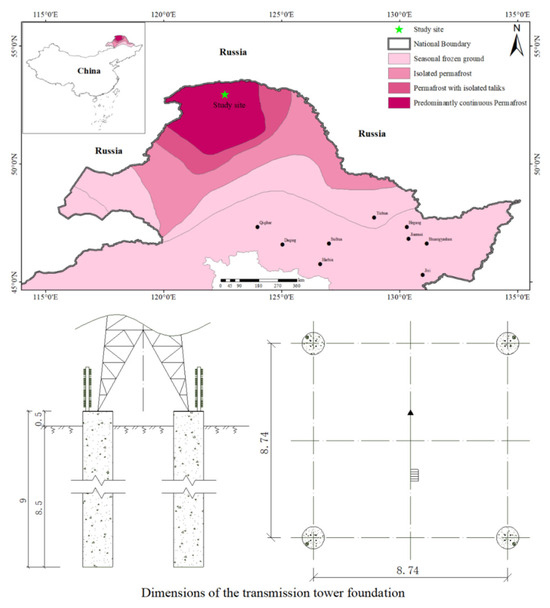
Figure 1.
Geographic location of the study area and schematic layout of the engineering structure: permafrost data originate from [22] (unit: m).
2.2. Heat Transfer Theory
Given the extremely low permeability of the soil layers, heat transfer during freezing and thawing processes is predominantly governed by thermal conduction, with convective heat transfer being negligible in comparison. Consequently, mass transfer effects are excluded from the calculations, and the heat transfer analysis focuses solely on conduction through the soil matrix and the water content, incorporating the phase change of water. The phase-change heat transfer process is divided into two stages: freezing (Ωf) and thawing (Ωu) [23,24].
In Ωf,
In Ωu,
where and are the temperatures of the soil in the frozen and thawing states, respectively; and represent the specific heat capacities of the soil in the frozen and thawing states, respectively; and and represent the thermal conductivities of the soil in the frozen and thawing states, respectively.
Based on the continuity of the two equations and the principle of energy conservation, within the phase change zone s(t), the following holds:
where L represents the latent heat of phase change.
In this calculation, the latent heat associated with the phase change of water is approximated by utilizing the sensible heat capacity method. This approach simplifies the complex energy exchanges during phase transitions by assuming that the heat required for phase change can be accounted for by a corresponding change in the sensible heat of the system. As a result, the latent heat is incorporated into the system’s heat capacity, allowing for a more straightforward calculation while still capturing the essential thermal behavior of water as it undergoes freezing or thawing. This method is particularly useful in situations where the exact phase change process is difficult to model directly, yet its effect on the thermal dynamics remains significant. It is assumed that the phase change in the soil–water medium occurs within a specified temperature range . When determining the equivalent volumetric heat capacity for this temperature range, the effect of the temperature interval should be taken into account. The volumetric heat capacity and thermal conductivity of both frozen and unfrozen soil, denoted as and , and , respectively, are temperature-independent [24]. Therefore, the piecewise expressions for and can be simplified as follows:
Based the on related literature [15,25], the total thermal resistance (∑Ri) of a TPCT is dominated by three components: condensation section resistance (R1–R3), adiabatic section resistance (R4), and evaporation section resistance (R5–R6). The condensation section includes R1, R2, and R3. R1 is the thermal resistance for heat exchange between the outer wall of the condensation section and the air:
where doc is the outer diameter of the condensation section tube, Lc is the length of the condensation section, n is the number of heat fins, δ is the thickness of the heat fins, η is the reduction coefficient, λa is the thermal conductivity of air, Re is the Reynolds number for air, Pra is the Prandtl number, and V is the wind speed.
R2 is the thermal resistance of the tube wall in the condensation section:
where dic is the inner diameter of the condensation section tube and λc is the thermal conductivity of the tube wall.
R3 is the phase change thermal resistance of the working fluid in the condensation section:
where ll is the latent heat of phase change of the working fluid.
R4 is the thermal resistance of the adiabatic section:
The thermal resistance of the evaporation section includes R5 and R6:
where die is the inner diameter of the evaporation section tube and Le is the length of the evaporation section.
The total thermal resistance of the TPCT can be expressed as:
The heat flux of the TPCT is:
2.3. Major Parameters
The geotechnical parameters for soil layers and pile foundations were determined through an integrated analysis of drilling survey data from the study area, supplemented by prior investigations by Lu [26] in this region and relevant studies [5], as systematically summarized in Table 1. These thermophysical properties were subsequently mapped to corresponding stratigraphic units in the numerical model, utilizing high-resolution borehole logging data obtained from Mohe County. The main parameters of the TPCT selected in the mathematical model are shown in Table 2.

Table 1.
Thermophysical parameters of soil layers and concrete.

Table 2.
TPCT major sizes.
2.4. Computational Domain and Boundary Conditions
Given that the experimental model meets the symmetry conditions, a quarter of the transmission tower foundation structure is selected as the geometric model for calculation and analysis, as shown in Figure 2. Taking into account the effects of global climate change and incorporating prior surface temperature monitoring data from the study area [26], the temperature variation in the face ABCD is represented as:
where t is the time variable. Symmetrical boundary conditions are applied to the faces ABEF and ADHE.
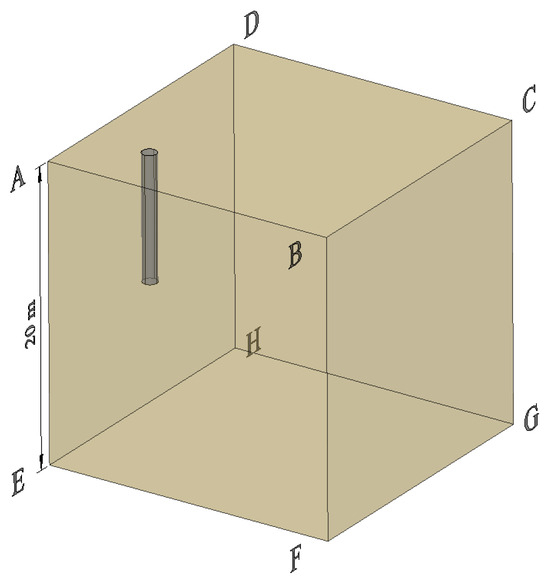
Figure 2.
Schematic representation of the computational domain.
3. Results
3.1. Freeze-Thaw Characteristics
Figure 3 illustrates the freeze–thaw process of natural boreholes and two types of pile schemes. It is evident that, with the continued rise in temperature, the permafrost table gradually descends. Over the 30-year period, the permafrost table at the three monitoring locations dropped by 0.29 m, 0.43 m, and 0.30 m, respectively. In terms of the rate of descent, the depth of the permafrost table at the three locations descended at rates of 0.1 m, 0.12 m, and 0.05 m per decade during the first 10 years; 0.08 m, 0.14 m, and 0.12 m per decade between 10 and 20 years; and 0.11 m, 0.18 m, and 0.13 m per decade between 20 and 30 years. Regarding the degree of permafrost degradation, the CP scheme exhibited the most significant degradation, followed by the TP scheme, while the degradation in the natural borehole was comparatively less pronounced. By the 10th year, the depths of the permafrost table at the three locations were 3.01 m, 3.33 m, and 3.18 m, respectively. By the 20th year, these depths had increased to 3.08 m, 3.46 m, and 3.30 m. By year 30, the permafrost tables at the three locations had descended to depths of 3.2 m, 3.64 m, and 3.44 m. At this point, the CP scheme’s permafrost table was 0.2 m deeper than the TP scheme and 0.44 m deeper than the natural borehole. This indicates that the cooling effect of the TPCT has alleviated the downward movement of the permafrost table to some extent. Furthermore, the permafrost table at both pile sites is deeper than at the natural borehole, suggesting that the thermal conductivity of the pile foundation material has increased the rate of soil thawing and heat absorption during the warm season. As for the deep soil temperature, all three locations showed an increasing trend due to climate warming. The temperature rise at the natural borehole and CP scheme pile sites was more pronounced, while the TP scheme exhibited a slower increase in temperature due to the cooling effect of the TPCT. Additionally, Case 2 showed significantly lower deep soil temperatures compared to both the natural borehole and Case 1. Between years 20 and 30, the deep soil temperature at the natural borehole and Case 1 ranged from 0 °C to −2 °C, while in Case 2, certain areas had temperatures lower than −2 °C, with the −4 °C isotherm extending to depths below 7 m. While the integration of TPCTs into cast-in-place pile foundations effectively lowers deep soil temperatures surrounding the piles, their capacity to regulate the permafrost table remains constrained.
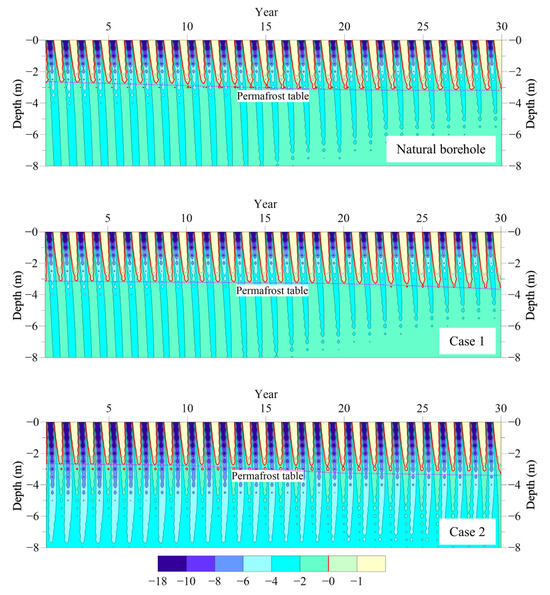
Figure 3.
Freeze–thaw processes along the natural borehole and pile sides in the two cases.
3.2. Ground Temperature Field Distribution
Figure 4 shows the temperature distribution around the piles for the two schemes. From the comparison of the temperature fields at four different time points, it is clear that on 15 October, the temperature difference between the two conditions with and without TPCT primarily occurs in the deeper layers. The −1 °C isotherm on the pile side in Case 2 is noticeably higher than in Case 1, and within the 5–8 m depth range on the pile side of Case 2, the soil temperature is below −1 °C. However, the position of the 0 °C isotherm in both cases does not show significant differences. As winter sets in, the TPCT begins to operate, cooling the pile. The pile-side temperature in the TP scheme decreases significantly, and by 15 January, the temperature on the pile side is completely below −3 °C, as indicated by the −3 °C isotherm. In contrast, most of the pile temperature in the CP scheme remains above −1 °C, with the area where the temperature is above −1 °C significantly larger than in the TP scheme. Then, as the temperature gradually rises, the efficiency of the TPCT decreases. By 15 April, the temperature difference between the two schemes has reduced, especially in the TP scheme, where the pile-side temperature shows an upward trend. Compared to January, both the shallow and deep pile temperatures have risen, as indicated by the −3 °C isotherm. At this point, the temperature distribution around the TP scheme piles tends to become more uniform. After winter, as temperatures rise and the TPCT stops working, the soil near the TP scheme pile reaches a steady ground temperature, continuing to absorb heat from the surrounding relatively warmer soil. By 15 July, the temperature distributions for both conditions show very little difference, as seen in the −1 °C, 0 °C, and 3 °C isotherms. Overall, during the cold period, the TPCT provides significant cooling and offers a marked low-temperature advantage. However, as the warm season progresses and the TPCT ceases to function, this low-temperature advantage gradually diminishes. Notably, by the end of the warm season, the TP scheme still retains some low-temperature advantage in the deeper layers, as shown in Figure 4a.
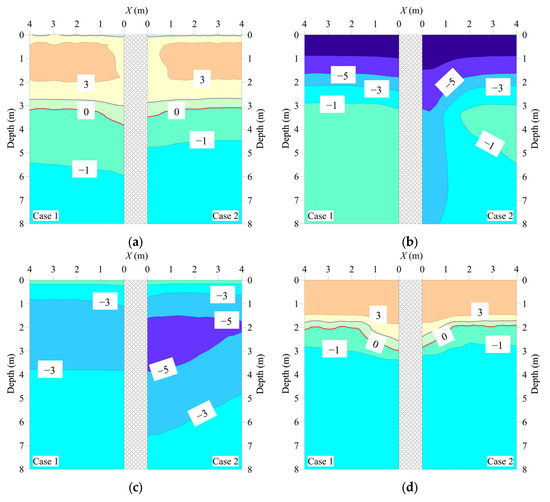
Figure 4.
Temperature distribution profiles around the pile foundations. (a) October 15th; (b) January 15th; (c) April 15th; (d) July 15th.
3.3. Temperature Profile of Pile Sides
To quantitatively assess the cooling effect of the cooling device, Figure 5 presents the temperature profile of the pile sides for the two schemes. Overall, as winter progresses and the temperature drops, the temperature difference between the two schemes increases. With the cooling effect of the TPCT, the temperature on the pile side in the TP scheme drops rapidly. For example, at depths of 4 m and 6 m, the temperature difference between the two schemes on November 15 is 1.27 °C and 1.63 °C, respectively. By 15 January, the temperature difference increases to 4.05 °C and 3.79 °C, and by 15 March, the differences are 4.13 °C and 3.43 °C, respectively. As the warm season begins, the temperature difference between the two schemes gradually decreases. On 15 May, the average temperature difference on the pile side is 0.9 °C, and by 15 July, this difference decreases to 0.49 °C. Although TPCTs are inactive in summer, residual cooling energy stored in the pile and adjacent soil during winter is gradually released to deeper soil layers due to the thermal inertia of concrete. By 15 September, the temperature difference narrows further to 0.33 °C, with a temperature difference of 0.51 °C at a depth of 7 m. In other words, although the TP scheme pile continues to absorb heat and warm up during the warm season, it still exhibits a notable low-temperature advantage by the end of the warm season. This result is significant for optimizing pile foundation design.
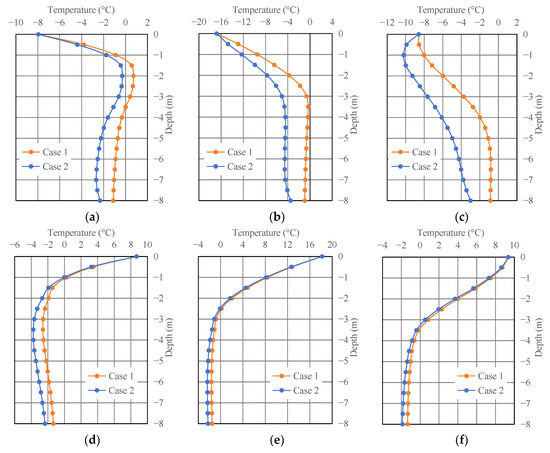
Figure 5.
Temperature profiles along the sides of the pile foundations. (a) November 15th; (b) January 15th; (c) March 15th; (d) May 15th; (e) July 15th; (f) September 15th.
3.4. Response of Cooling Performance to Climate Warming
Figure 6, Figure 7 and Figure 8 show the annual average, annual maximum, and annual minimum temperature changes at four pile-side depth levels. Overall, under the backdrop of climate warming, the ground temperature shows a gradual increasing trend. However, due to the cooling effect of the TPCT, significant temperature differences exist between the two schemes in terms of the annual average, maximum, and minimum temperatures on the pile sides. Firstly, by the fifth year, the annual average temperature difference between the two schemes at the four depths ranges from 1.27 °C to 1.86 °C. By the 30th year, the difference varies between 1.33 °C and 1.86 °C, with the temperature difference between the two schemes showing little change over time. At the 30th year, the differences in the annual minimum temperatures at depths of 2 m, 4 m, 6 m, and 8 m are 3.94 °C, 3.34 °C, 2.78 °C, and 1.98 °C, respectively, while the differences in the annual maximum temperatures are 0.31 °C, 0.26 °C, 0.68 °C, and 0.81 °C. It can be observed that the temperature differences between the two schemes exhibit significant seasonal fluctuations at all four depths, with clear variations between the cold and warm seasons. This indicates that when the warm season arrives and the TPCT ceases to operate, the cold energy stored during the winter dissipates rapidly. Furthermore, after a prolonged period of climate warming, the installation of TPCT in borehole-cast piles still effectively maintains the thermal stability. This is crucial for reducing disaster risks during the operation of pile foundations in frozen soil regions.
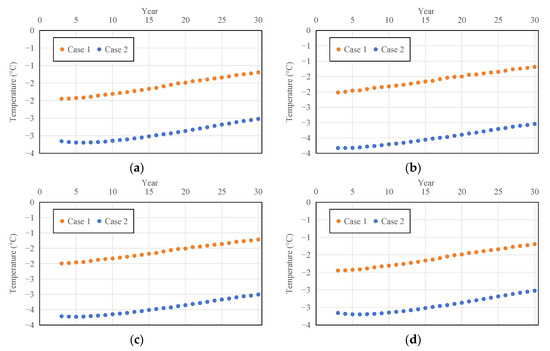
Figure 6.
Variation of annual average temperature on the pile side. (a) Depth = 2 m, (b) Depth = 4 m, (c) Depth = 6 m, (d) Depth = 8 m.

Figure 7.
Variation of annual maximum temperature on the pile side. (a) Depth = 2 m, (b) Depth = 4 m, (c) Depth = 6 m, (d) Depth = 8 m.
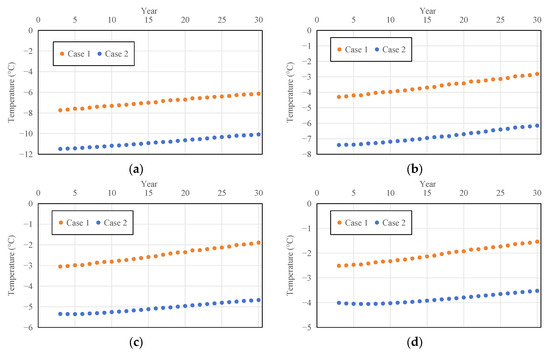
Figure 8.
Variation in annual minimum temperature on the pile side. (a) Depth = 2 m, (b) Depth = 4 m, (c) Depth = 6 m, (d) Depth = 8 m.
3.5. Energy Exchange Process
Figure 9 presents the annual average heat flux at the pile side in the TP scheme. First, in terms of the time dimension, the cooling efficiency of the device shows a slight decline as the temperature increases. For depths between 4 m and 8 m, the cooling efficiency decreases by 4% to 6% over the course of 30 years. In terms of spatial variation, the device exhibits higher cooling efficiency at depths between 5 m and 6 m, where the annual average heat flux at the pile side ranges from −2.22 to −2.33 W/m2. To understand the operating conditions of the TP scheme, Figure 10 illustrates the variation of heat flux along the pile side. In terms of operation time, the TP scheme mainly functions from early October to the end of March of the following year, with the remainder of the time being spent in a shutdown state. As winter arrives and temperatures gradually decrease, the cooling efficiency of the TP scheme strengthens, reaching its peak in early January. Then, as the temperature rises, the heat absorption efficiency of the pile side gradually weakens. Notably, during the warm season, the pile exhibits a heat release state in relation to the surrounding soil. This phenomenon is observed at depths greater than 6 m, primarily due to heat in the air being transferred more rapidly through the pile foundation to the underground soil, causing the pile temperature in certain depth ranges to be higher than that of the surrounding soil, thus exhibiting a heat release state.
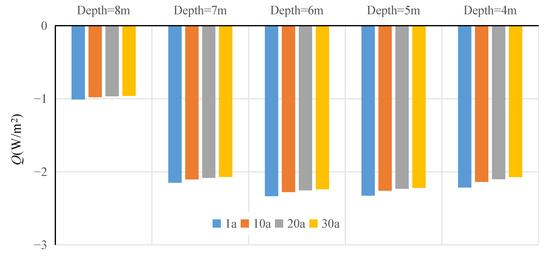
Figure 9.
Annual average heat flux at the pile side in TP scheme.
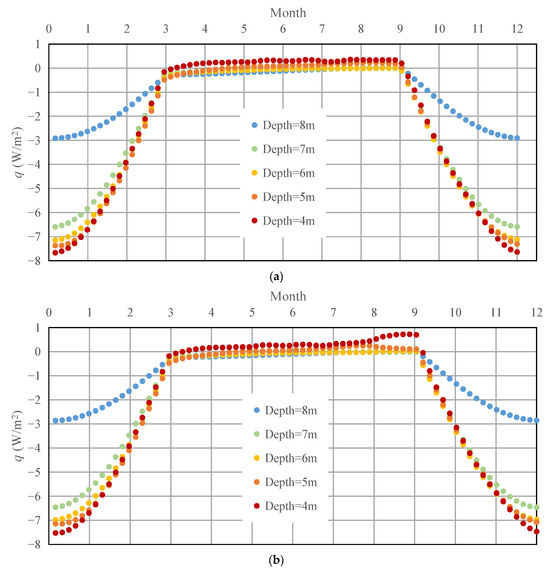
Figure 10.
Variation in heat flux along the pile side in the TP scheme. (a) 5a; (b) 29a.
4. Conclusions
Climate change has increased the disaster risk for cast-in-place pile foundations of transmission towers in high-latitude permafrost regions. This study proposes the use of TPCT as a cooling measure for tower foundations and quantifies the cooling effect of TPCT in cast-in-place pile foundations through a mathematical model. Based on the research findings, the following conclusions can be drawn:
- The integration of TPCTs into cast-in-place pile foundations partially mitigates the downward migration of the permafrost table around transmission tower foundations induced by climate warming. While the cooling effect of TPCTs effectively slows the rate of permafrost thaw, their ability to fully stabilize the permafrost table remains limited.
- The operational efficiency of TPCT-enhanced cast-in-place pile foundations is highly temperature-dependent, with an effective cooling period spanning from early October to late March annually.
- TPCT-equipped cast-in-place pile foundations provide efficient ground temperature regulation, effectively counteracting permafrost degradation driven by climate change. This significantly reduces the risk of structural damage to transmission tower foundations in permafrost regions.
This study verifies the cooling effectiveness of TPCT-integrated pile foundations for transmission lines in permafrost regions through numerical simulations. Subsequent research will optimize TPCT designs, validate long-term mechanical impacts via field trials, and systematically evaluate the economic and engineering feasibility of implementing these systems in large-scale infrastructure engineering in permafrost regions.
Author Contributions
L.Z.: conceptualization, methodology, visualization, writing—original draft. Y.X.: conceptualization, methodology, visualization, writing—original draft. Y.S.: methodology, investigation, visualization, writing—review and editing, supervision, project administration, funding acquisition. Y.L.: methodology, investigation, visualization, writing—review and editing. X.W.: validation, methodology, investigation, visualization. All authors have read and agreed to the published version of the manuscript.
Funding
This research was funded by the Natural Science Foundation of Gansu Province (23JRRA660, 25JRRA504, 25JRRA498).
Data Availability Statement
The original contributions presented in this study are included in the article. Further inquiries can be directed to the corresponding author.
Conflicts of Interest
Authors Lei Zhao and Yao Xiao were employed by Economic and Technological Research Institute of State Grid Heilongjiang Electric Power Co., Ltd. The remaining authors declare that the research was conducted in the absence of any commercial or financial relationships that could be construed as a potential conflict of interest. The company had no role in the design of the study; in the collection, analyses, or interpretation of data; in the writing of the manuscript; or in the decision to publish the results.
References
- Andersland, O.B.; Ladanyi, B. Frozen Ground Engineering; John Wiley & Sons: Hoboken, NJ, USA, 2004. [Google Scholar]
- Gao, Z.Y.; Zhang, C.M.; Liu, W.Y.; Niu, F.J.; Wang, Y.B.; Lin, Z.J.; Yin, G.A.; Ding, Z.K.; Shang, Y.H.; Luo, J. Extreme degradation of alpine wet meadow decelerates soil heat transfer by preserving soil organic matter on the Qinghai–Tibet Plateau. J. Hydrol. 2025, 653, 13278. [Google Scholar]
- Xu, X.Z.; Wang, J.C.; Zhang, L.X. Frozen Soil Physics; Science Press: Beijing, China, 2001. [Google Scholar]
- Ma, W.; Wang, D.Y. Frozen Soil Mechanics; Science Press: Beijing, China, 2014. [Google Scholar]
- Shang, Y.H.; Niu, F.J.; Li, G.Y.; Fang, J.H.; Gao, Z.Y. Application of a Concrete Thermal Pile in Cooling the Warming Permafrost Under Climate Change. Adv. Clim. Chang. Res. 2024, 15, 170–183. [Google Scholar]
- Aksenov, V.I.; Kistanov, O.G. Estimation of resistance components to an axial load on piles embedded in permafrost. Soil Mech. Found. Eng. 2008, 45, 71–75. [Google Scholar] [CrossRef]
- Shang, Y.H.; Niu, F.J.; Fang, J.H.; Wu, L.B. Experimental study on thermal regime and frost jacking of pile foundation during operation period in permafrost regions. Front. Earth Sci. 2022, 10, 821305. [Google Scholar]
- Harris, S.A.; Brouchkov, A.; Cheng, G.D. Geocryology: Characteristics and Use of Frozen Ground and Permafrost Landforms; CRC Press: Boca Raton, FL, USA, 2018. [Google Scholar]
- Hjort, J.; Streletskiy, D.; Doré, G.; Wu, Q.B.; Bjella, K.; Luoto, M. Impacts of permafrost degradation on infrastructure. Nat. Rev. Earth Environ. 2022, 3, 24–38. [Google Scholar] [CrossRef]
- Wu, J.J.; Ma, W.; Sun, Z.Z.; Wen, Z. In-situ study on cooling effect of the two-phase closed thermosyphon and insulation combinational embankment of the Qinghai–Tibet Railway. Cold Reg. Sci. Technol. 2010, 60, 234–244. [Google Scholar]
- Zhang, B.; Sheng, Y.; Chen, J.; Li, J. In-situ test study on the cooling effect of two-phase closed thermosyphon in marshy permafrost regions along the Chaidaer–Muli Railway, Qinghai Province, China. Cold Reg. Sci. Technol. 2011, 65, 456–464. [Google Scholar] [CrossRef]
- Zhang, M.Y.; Lai, Y.M.; Zhang, J.M.; Sun, Z.Z. Numerical study on cooling characteristics of two-phase closed thermosyphon embankment in permafrost regions. Cold Reg. Sci. Technol. 2011, 65, 203–210. [Google Scholar] [CrossRef]
- Yu, F.; Qi, J.L.; Zhang, M.Y.; Lai, Y.M.; Yao, X.L.; Liu, Y.Z.; Wu, G.L. Cooling performance of two-phase closed thermosyphons installed at a highway embankment in permafrost regions. Appl. Therm. Eng. 2016, 98, 220–227. [Google Scholar]
- Yu, F.; Zhang, M.Y.; Lai, Y.M.; Liu, Y.Z.; Qi, J.L.; Yao, X.L. Crack formation of a highway embankment installed with two-phase closed thermosyphons in permafrost regions: Field experiment and geothermal modeling. Appl. Therm. Eng. 2017, 115, 670–681. [Google Scholar] [CrossRef]
- Pei, W.S.; Zhang, M.Y.; Lai, Y.M.; Yan, Z.R.; Li, S.Y. Evaluation of the ground heat control capacity of a novel air-L-shaped TPCT-ground (ALTG) cooling system in cold regions. Energy 2019, 179, 655–668. [Google Scholar] [CrossRef]
- Zhang, M.Y.; Pei, W.S.; Lai, Y.M.; Niu, F.J.; Li, S.Y. Numerical study of the thermal characteristics of a shallow tunnel section with a two-phase closed thermosyphon group in a permafrost region under climate warming. Int. J. Heat Mass Transf. 2017, 104, 952–963. [Google Scholar]
- Fedorovich, D.I.; Targulyan, Y.O. Pile foundation construction characteristics in the alaska oil pipeline. Constr. Under Spec. Soil Cond. 1991, 5, 6–8. [Google Scholar]
- Guo, L.; Yu, Q.H.; You, Y.H.; Wang, X.B.; Li, X.N.; Chang, Y. Cooling effects of thermosyphons in tower foundation soils in permafrost regions along the Qinghai–Tibet Power Transmission Line from Golmud, Qinghai Province to Lhasa, Tibet Autonomous Region, China. Cold Reg. Sci. Technol. 2016, 121, 196–204. [Google Scholar]
- Guo, L.; Zhang, Z.Q.; Wang, X.B.; Yu, Q.H.; You, Y.H.; Chang, Y.; Xie, Y.L.; Gou, T.T. Stability analysis of transmission tower foundations in permafrost equipped with thermosiphons and vegetation cover on the Qinghai-Tibet Plateau. Int. J. Heat Mass Transf. 2018, 121, 367–376. [Google Scholar]
- You, Y.H.; Yu, Q.H.; Wang, X.B.; Guo, L.; Chen, K.; Wu, Q.B. Effects of thermosyphons on the thermal regime and stability of cast-in-place piles in permafrost regions on the Qinghai-Tibet Plateau. Permafr. Periglac Process. 2022, 33, 277–285. [Google Scholar] [CrossRef]
- Sun, T.; Guo, H.X.; Zhou, T.B.; Suo, H.N.; Dong, T.C.; Zhang, M.G. Study on active thermal protection for bridge pier in permafrost regions by using thermosyphon group. J. Glaciol. Geocryol. 2023, 45, 1555–1563. [Google Scholar]
- Jin, H.J.; Hao, J.Q.; Chang, X.L.; Zhang, J.M.; Yu, Q.H.; Qi, J.L.; Lü, L.Z.; Wang, S.L. Zonation and assessment of frozen-ground conditions for engineering geology along the China-Russia crude oil pipeline route from Mo’he to Daqing, Northeastern China. Cold Reg. Sci. Technol. 2010, 64, 213–225. [Google Scholar] [CrossRef]
- Lai, Y.M.; Zhang, M.Y.; Li, S.Y. Theory and Application of Cold Regions Engineering; Science Press: Beijing, China, 2009. [Google Scholar]
- Yu, W.B. Study on Special Embankment in Permafrost Regions of Qinghai-Tibet Railway. Ph.D. Thesis, University of Chinese Academy of Sciences, Beijing, China, 2003. [Google Scholar]
- Lai, Y.M.; Wang, Q.S.; Niu, F.J.; Zhang, K.H. Three-dimensional nonlinear analysis for temperature characteristic of ventilated embankment in permafrost regions. Cold Reg. Sci. Technol. 2004, 38, 165–184. [Google Scholar]
- Lu, Y. Study on the Change of Permafrost in urban Environment–A Case Study of Mohe County. Ph.D. Thesis, University of Chinese Academy of Sciences, Beijing, China, 2018. [Google Scholar]
Disclaimer/Publisher’s Note: The statements, opinions and data contained in all publications are solely those of the individual author(s) and contributor(s) and not of MDPI and/or the editor(s). MDPI and/or the editor(s) disclaim responsibility for any injury to people or property resulting from any ideas, methods, instructions or products referred to in the content. |
© 2025 by the authors. Licensee MDPI, Basel, Switzerland. This article is an open access article distributed under the terms and conditions of the Creative Commons Attribution (CC BY) license (https://creativecommons.org/licenses/by/4.0/).